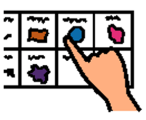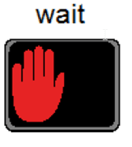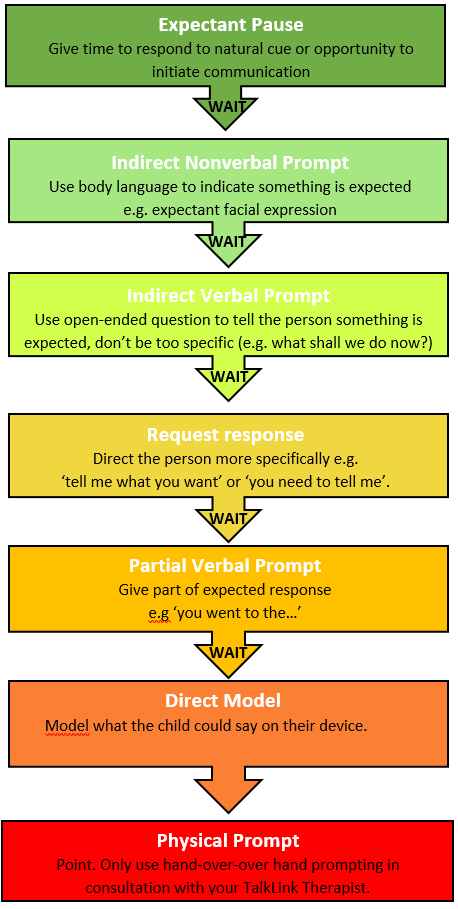Tip of the Month February 2017: Prompting
Prompts are cues designed to support a person using a communication system take up a communication opportunity.
It is easy to fall into the trap of wanting a person to use their communication system so much that you jump in too quickly and over prompt them using physical, verbal and visual prompts. Over prompting may not encourage independent communication and may cause a person who uses a communication system to become prompt dependent (not communicating unless someone prompts them to).

Begin with the end in mind
The long term goal for users of alternative communication is;
The person will have independent spontaneous communication; that is to say what they want, when they want, to who they want.
Model, model model!
Before a client can use any communication system they need to see others using it to communicate to them. This is called Aided Language Stimulation. Before using any kind of prompt with a client they need to have seen you model the device yourself in multiple contexts to communicate.
Please see this previous Tip of the Month to learn more about modelling.
Expectant Pause
The most important cue we can use is an expectant pause.
This can be accompanied by an expectant facial expression and a long pause.
Many of our clients take longer to process information and to organise their muscle movement, therefore allowing them time to communicate is essential.
If you are not sure how long to wait, start with counting to 10 slowly in your head. Some people need up to 60 seconds of waiting in silence in order to process the information and then get their bodies to respond. Each time you ask another question or use another prompt you essentially ‘reset’ the timer and they have to process again and get their bodies to respond all over again. The process of communicating with AAC is much quicker when we embrace silence and just wait.

Prompt Hierarchy (adapted from Senner, 2010; YAACK, 1999)
Start with the least amount of prompting and provide lots of wait time.

How do I avoid over-prompting?
Listen/look at yourself when you are working with a client and ask yourself;
- Am I modelling using the person’s system in multiple situations throughout the day?
- Am I providing lots of wait time?
- Am I making sure I don’t talk/point during the wait time?
- Is the person motivated to communicate in this situation?
- Am I following the prompt hierarchy starting from the least amount of prompting?
Another great way to reflect on your levels of prompting is to video yourself and then watch it as a team, as it is hard to reflect on your prompting when you are ‘in the moment’.
References:
- Prompting Heirarchy (Senner, 2010; YAACK, 1999) adapted from Positive AACtion Information Kit for AAC Teams. Retrieved from: http://www.rockybay.org.au/wp-content/uploads/2013/04/6.4-Prompting-Techniques-to-Support-AAC-Use.pdf
- Goal from PODD Introductory Workshop, Gayle Porter, 2012.
Created by Rosanna Tilyard, Speech-Language Therapist, 15.12.2016
For a PDF version of this Tip of the Month, download it here
Prompts are cues designed to support a person using a communication system take up a communication opportunity.
It is easy to fall into the trap of wanting a person to use their communication system so much that you jump in too quickly and over prompt them using physical, verbal and visual prompts. Over prompting may not encourage independent communication and may cause a person who uses a communication system to become prompt dependent (not communicating unless someone prompts them to).

Begin with the end in mind
The long term goal for users of alternative communication is;
The person will have independent spontaneous communication; that is to say what they want, when they want, to who they want.
Model, model model!
Before a client can use any communication system they need to see others using it to communicate to them. This is called Aided Language Stimulation. Before using any kind of prompt with a client they need to have seen you model the device yourself in multiple contexts to communicate.
Please see this previous Tip of the Month to learn more about modelling.
Expectant Pause
The most important cue we can use is an expectant pause.
This can be accompanied by an expectant facial expression and a long pause.
Many of our clients take longer to process information and to organise their muscle movement, therefore allowing them time to communicate is essential.
If you are not sure how long to wait, start with counting to 10 slowly in your head. Some people need up to 60 seconds of waiting in silence in order to process the information and then get their bodies to respond. Each time you ask another question or use another prompt you essentially ‘reset’ the timer and they have to process again and get their bodies to respond all over again. The process of communicating with AAC is much quicker when we embrace silence and just wait.

Prompt Hierarchy (adapted from Senner, 2010; YAACK, 1999)
Start with the least amount of prompting and provide lots of wait time.

How do I avoid over-prompting?
Listen/look at yourself when you are working with a client and ask yourself;
- Am I modelling using the person’s system in multiple situations throughout the day?
- Am I providing lots of wait time?
- Am I making sure I don’t talk/point during the wait time?
- Is the person motivated to communicate in this situation?
- Am I following the prompt hierarchy starting from the least amount of prompting?
Another great way to reflect on your levels of prompting is to video yourself and then watch it as a team, as it is hard to reflect on your prompting when you are ‘in the moment’.
References:
- Prompting Heirarchy (Senner, 2010; YAACK, 1999) adapted from Positive AACtion Information Kit for AAC Teams. Retrieved from: http://www.rockybay.org.au/wp-content/uploads/2013/04/6.4-Prompting-Techniques-to-Support-AAC-Use.pdf
- Goal from PODD Introductory Workshop, Gayle Porter, 2012.
Created by Rosanna Tilyard, Speech-Language Therapist, 15.12.2016
For a PDF version of this Tip of the Month, download it here
